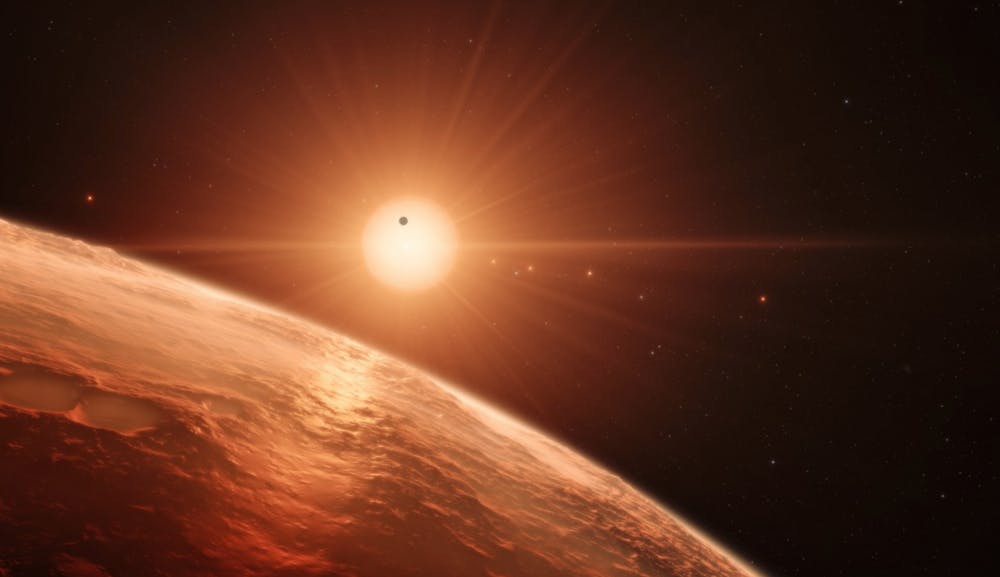Forty light years away, seven exoplanets have caused scientists to ask if there is life beyond our own.
The National Aeronautics and Space Administration discovered seven possibly habitable planets rotating around a single star—called TRAPPIST-1—outside of our solar system last month. Three of these seven planets are located firmly within the habitable zone, or the area around the parent star where a rocky planet is most likely to have liquid water.
But Mark Kruse, Fuchsberg-Levine family professor of physics, said these results should not be sensationalized just yet. NASA, he said, is taking a more realistic approach.
“It’s typically the media that jumps into speculation, saying, ‘Well, these are Earth-like planets, and they’re in the so-called habitable zone, which is the zone where the conditions are such that they can support liquid water,’ and it is our belief that life can’t exist unless there is liquid water available on a particular planet,” he said.
In our solar system, Venus and Earth are in the habitable zone. However, planets too close to the sun like Mercury have only vaporized water, and planets too far away have only ice. Regarding the exoplanets, professors that The Chronicle spoke to had varying justifications for the viability of life elsewhere.
Nicholas Gillham, James B. Duke professor emeritus of zoology, noted that the seven exoplanets are likely rocky based on their densities. The closest ones to the star may be cool enough for liquid water to exist on their surfaces.
He explained that the TRAPPIST-1 system’s star may be a red dwarf, which emits far less heat than our sun and could take trillions of years to burn out.
Cliff Cunningham, professor in the department of biology, said life can survive in surprising conditions, citing Earth’s Deep Sea as an example. He explained that if certain organisms can thrive in the Deep Sea, where absolutely no natural sunlight penetrates the ecosystem, then it is not unreasonable to think that life could similarly survive in other places like Jupiter’s moon Europa or the newly-discovered exoplanets.
Dan McShea, another professor in the department of biology, also said life might be possible given the right chemical conditions.
He explained that complexity, diversity, stability, homeostasis and the ability to evolve through natural selection can all arise spontaneously when chemicals in the environment are adequately reactive with each other.
“You’re not going to get life in a very simple system with only a few parts and a few kinds of connections. But you’re also not going to get it in a complex system where every part interacts with every other part, because this just creates chaos,” McShea said.
He noted that the presence of oxygen in the atmosphere might be a possible indicator that life may have begun to populate a particular planet.
“Oxygen is very reactive and doesn’t tend to hang around and accumulate unless it’s constantly being generated,” he said. “There wasn’t much oxygen in the atmosphere of the early Earth until oxygen-generating organisms evolved.”
Although the technology for determining whether more distant planets contain an atmosphere does not yet exist, Kruse said he is confident that we will acquire the necessary spectroscopic technology within the next decade.
The road to collecting these observations on the TRAPPIST-1 system is not without enormous challenges. The most obvious obstacle? Time.
NASA's spacecraft Juno, which reached Jupiter last summer after five years of traveling, is the fastest human-made vessel so far. It would take a craft traveling at the same speed about 4,000 years to reach TRAPPIST-1, Kruse explained.
“If you could travel at the speed of light, you would get there in 40 years," Kruse said. "It would be a huge engineering feat if you could travel at a tenth of the speed of light."
He went on to note other issues with the TRAPPIST-1 star—such as being both very cold compared to our sun and only about a tenth the size. This means that in order for the planets to be in the habitable zone, they must be orbiting very close to the star. Because only one side of the planet ever faces the star at a time, there could be extreme temperature variations across the planet, making it difficult to maintain life.
Regardless of these setbacks, however, there is still plenty of optimism in the scientific community.
The discovery of TRAPPIST-1 and its orbiting planets offers the exciting and real possibility of testing widely-held assumptions that life should have evolved many times in our universe, noted Emily Bernhardt, associate professor of biogeochemistry, in an email.
Get The Chronicle straight to your inbox
Sign up for our weekly newsletter. Cancel at any time.
“What we learn about space often dramatically changes how we understand ourselves,” Bernhardt wrote. “Now, the potential to discover evidence that we are not the only 'living' planet offers the same opportunity to revise how we understand the universe and our place within it.”
Kruse said as long as NASA’s mission is to explore new worlds, then this is no more than an extension of what humankind has "done forever."
“We’ve explored the Earth, and now we’ve extended our boundaries—and we want to keep exploring the place we live in, and that is just fine,” he said.

